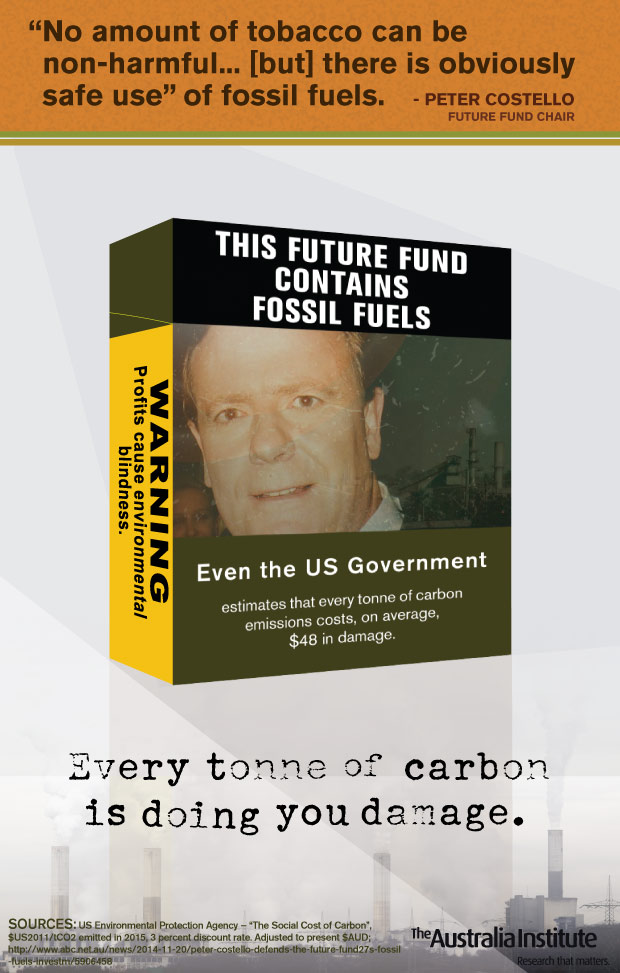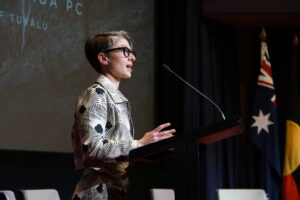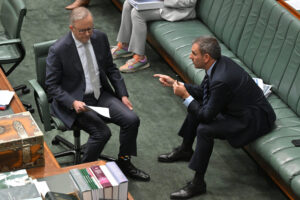Fueling inequality
- Divestment on the agenda
- Gender pay gap continues to cost women
- Are we beginning to overcome Indigenous disadvantage?
- Infographic
Divestment on the agenda
Australia Financial Review might have gone totally overboard in its attack on ANU, but now it seems everyone’s talking about divestment. It was top of mind at the recent Responsible Investment Association of Australia conference; where funds representing hundreds of billions came together and where the topic of fossil fuel divestment was raised in most sessions. Investors are learning about new fossil free indexes and funds that allow funds to avoid carbon risk while delivering competitive returns.
Interest at the big end of town is driven by the interest on the ground, and an eager crowd joined us to hear all about it at Politics in the Pub this week. Simon Sheikh, founder of Australia’s first fossil free superannuation fund – Future Super, spoke about divestment as a way to drive change in the super sector. Tom Swann, a long running Fossil Free ANU campaigner and researcher at the Australia Institute, spoke about his experiences campaigning for universities, religious groups and local governments to take a leadership role in helping Australia break it’s addiction to fossil fuels. We’ll have the footage online soon.
Divestment was also on the agenda at a recent Senate hearing. Peter Costello, now the Chair of Australia’s $105 billion Future Fund, was asked why the fund doesn’t invest in tobacco but does invest in fossil fuels, to which he said: “The answer that the board came to was no amount of tobacco can be non-harmful, whereas it doesn’t believe that every amount of oil is harmful or every amount of gas is harmful or every amount of coal is harmful.”
We checked the facts on that, and found that every tonne of carbon is doing us damage. Even the US Government thinks the average damage is $AUD48 per tonne of CO2 emitted now and rising. If the world’s 2-degree climate target is a ‘safety limit’, then the vast majority of carbon is unsafe – a point endorsed by the head of the Bank of England and which Obama’s climate envoy declared “obvious”.
“It would be a very strange thing for a country like Australia, which exports coal and which exports gas, for its government to say we think these things are so filthy and so wrong that we won’t even touch them on the stock market,” Mr Costello also said.
Meanwhile in Norway, a vigorous debate is underway about divesting their ‘oil fund’ from fossil fuels. The debate is not just about the environment, but about financial risk. Norway has taxed its oil sensibly and now has an $800 billion ‘oil fund’, owning more than one per cent of all stock in the world!
Christine Meisingset, head of sustainability research at Norwegian insurer Storebrand (which has itself divested a number of fossil fuel stocks), said: “As a country we are so exposed to fossil fuels, which is a risky position in the transition to a low-carbon economy. That makes the discussion around the oil fund so important.”
Maybe they should have a chat?
Gender pay gap continues to cost women
This week the Workplace Gender Equality Agency released a new report providing the most comprehensive picture ever of gender equality in Australian workplaces.
The report presents some shocking findings about gender equality. The gender pay gap in Australia is growing and currently sits at 19.9 per cent for base pay, rising to 24.7 per cent for total remuneration.
This is an increase on statistics revealed in previous research by The Australia Institute, which calculated a 17.4 per cent the pay gap between Australian men and women. The same research found that the combination of the gender pay gap and time out of the workforce for caring equates to women earning $1.4 million less than men over a lifetime.
The rising gender pay gap means women are being paid nearly one quarter less than men to do the same job. Financial and Insurance Services is the worst performing industry for pay equality, with women earning 36.1 per cent less than men for total remuneration.
Although the gender pay gap is a rising concern, the report finds that only around a quarter of employees (24 per cent) have undertaken a gender pay gap analysis.
The report also finds the representation of women in the workforce declines the more you move up the management level. Women comprise only 26.1 per cent of key management positions and 17.3 per cent of CEO positions. As is well known, representation of women is low even at the government level with only one woman in the Federal Cabinet. While being underrepresented at the management level, women are over represented in administrative positions, making up more than three quarters of employees in the clerical and administrative workforce.
The data presented in the report by the Workplace Gender Equality Agency presents a bleak picture of gender equality in Australia. While there is much talk about the role of ‘choice’ when it comes to women and work, structural factors and gender bias appear to play a strong role. There is a strong argument for closing this gap and promoting women’s participation in work. Doing so will be beneficial to both workplace productivity and the economy in general. Australian workplaces and society need to take this report as a wakeup call and act to improve equality in Australia’s workforce.
Are we beginning to overcome Indigenous disadvantage?
The latest report on Overcoming Indigenous Disadvantage was released by the Productivity Commission this week and the results are a bit of a mixed bag. The report measures Australia’s progress toward nationally set indicators of the health and wellbeing of Aboriginal and Torres Strait Islander people.
It details new developments, new concerns, as well and new causes for optimism in working to break down some of the disadvantages impacting on Indigenous Australians.
Observers can take comfort from “some positive trends in the well being of Aboriginal and Torres Straight Islander Australians, with improvements in health, education and economic outcomes.” The proportion of 20-24 year olds successfully completing their high school diploma has increased 14 per cent since 2008, reaching nearly 60 per cent in 2013. Welfare dependency is falling amongst the adult Indigenous population, and 41 per cent of adults report living primarily on income from employment, up from 32 per cent in 2002.
Indigenous employment has fallen six per cent since 2008, the report finds. Hospitalisations for intentional self-harm has increased 48 per cent since 2004-05. Indigenous suicide rates remain nearly twice as high as non-indigenous Australians.
Aboriginal and Torres Straight Islander adults in 2012-13 were imprisoned at more than 13 times the rate of non-indigenous adults.
But while the facts are clear, the politics of the day are not. The government remains adamant that “throwing more money” at addressing indigenous disadvantage is not the solution. National Aboriginal Community Controlled Health Organisation chair Matthew Cooke, on the other hand, used a media release to blast the policy failures of state and federal governments, including the GP co-payment, and the failure to recommit to coordinated efforts to close the gap.
But there’s an enormous gap between throwing money everywhere in the hope that some of it lands in the right place and actively seeking to make savings off the back of some of Australia’s most vulnerable communities . As with most things in politics, the solutions are not clear cut. The most viable option will be one that falls in the space between irresponsible spending and irresponsible saving.
It’s a gap that needs to be closed, if the government is serious about closing the gap.
TAI in the media
Renewable energy proposal helps only existing hydro companies
Tasmania a big winner under RET scheme
Clever Leyonhjelm gives Abbott a template to kill wind power
Tasmania RET impact slammed as bogus, as shadow boxing continues
Canberra light rail: Experts urge caution, transparency with public-private partnership deals
Infographic

Between the Lines Newsletter
The biggest stories and the best analysis from the team at the Australia Institute, delivered to your inbox every fortnight.
You might also like
Bringing in the Budget | Between the Lines
The Wrap with Richard Denniss Budgets, like life, are all about priorities. It’s easy to talk about all the things we can do, but it’s harder to decide where we’re going to channel our efforts. And as in life, sometimes the hardest part of prioritising is telling other people that their priorities aren’t yours. On
The Climate Crisis is an Integrity Crisis | Polly Hemming
I am starting my address to this year’s summit in the exact same way that I started last year’s address. Because it is just over a year since I delivered these same words, which aren’t actually my words. They are the words of our Climate Change Minister, and they provide a baseline of sorts for what progress has been made in that time.
The Stage 3 tax cuts will make our bad tax system worse
Australia has one of the weakest tax systems for redistribution among industrial nations, and as Dr Jim Stanford writes, the Stage 3 tax cuts will make it worse.


